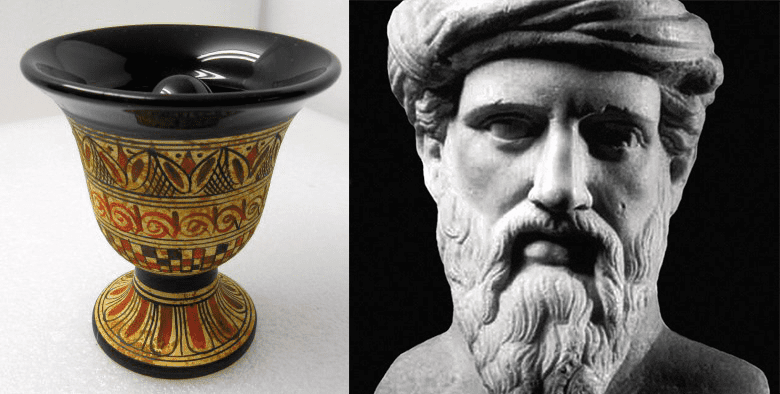
Known as one of the most enlightened minds of antiquity, Pythagoras of Samos left an invaluable legacy to the world. As a renowned mathematician, philosopher, and mystic, Pythagoras’ ideas were tremendously influential on the ancient world.
Whilst the 6th century BC Greek philosopher is foremost known for his mathematical innovations, such as his study of the property of numbers and his well-known geometric theorem that relates the sides of a right triangle in a simple way, not many people know he was also an accomplished inventor.
One of his many inventions is the Pythagorean cup, also known as the greedy cup – a clever and entertaining vessel designed to hold an optimal amount of wine, forcing people to imbibe only in moderation — a virtue of great regard among ancient Greeks.
If the user was too greedy and poured wine over the designed threshold, the cup would spill its entire content. Imagine the dismay and stupefaction a glutton felt when his precious brew perished on the floor.
Indeed, Pythagoras was always a professor at heart, and his contraption may have taught a couple of fellows about the virtue of moderation. But the ‘greedy cup’ also gives a lesson in ingenuity.
On the outside, the 2,500-year-old design looks like any other cup. However, when you make a cross-section, it becomes clear this is no ordinary vessel. At the center of the cup lies a mechanism consisting of a hollow pipe-like chamber that follows an opening, starting from the bottom of the liquid-holding part of the cup, up to the top of the central column that makes up the cup’s core, and back down 180 degrees out the bottom.
As the pipe curls over the top of the U-shaped central column, its floor marks an imaginary line. If you fill the cup over this horizontal line, the liquid will begin to siphon out the bottom and onto your lap or feet — the entire content of the cup, even the liquid below the line.


The siphon is created due to the interplay between gravity and hydrostatic pressure. Water tends to flow from the area of high pressure to the area of low pressure. When the liquid level rises such that it fills the U-shaped chamber, the liquid will start to fall due to gravity. As gravity pulls the water column down the pipe of the Pythagorean cup, the lower pressure thus created on the other end causes the liquid to be overpowered, subsequently allowing itself to be “dragged” along, stopping only when the water level either falls below the intake or the outlet. Some modern toilets operate on the same principle: when the water level in the bowl rises high enough, a siphon is created, flushing the toilet.
According to one account, which may be more myth than history, Pythagoras got the idea for his fabled cup while supervising workers or students at a water supply project in Samos island. There, he was troubled by the debauchery of the workers, so he came up with this ancient prank to ensure they only drank in moderation.
Today, Pythagorean cups can be bought all over Greece at souvenir shops and can even be ordered on eBay. If you’re up for pranks, this is a great gift. Be wary of wine though since it stains.



